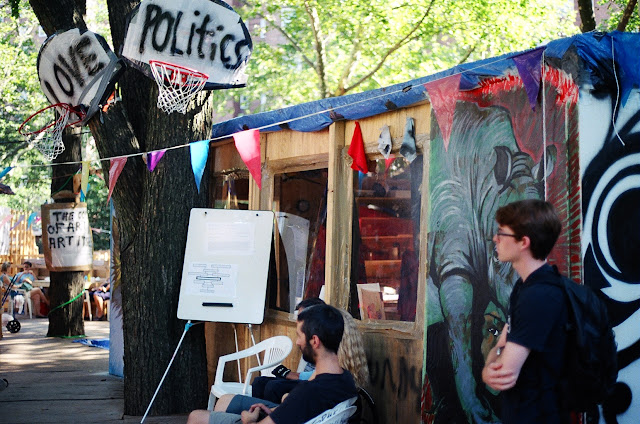Thomas Hirschhorn created this giant, rambling structure called the Gramsci Monument in the middle of the Forest Houses project in the Bronx. He and Forest Houses residents built the monument out of plywood, packing tape, and plexiglass, among other cheap materials. It encompasses an art studio, a newspaper office, a radio station, a museum with objects from Gramsci's life (like the medicine he took in prison), a library, a restaurant, a wading pool, and a lecture area.
Hirschhorn's philosophy is all about "Energy," instead of "Quality." The consistency and scale of his poor, ugly materials and scrawly handwriting add up to something unified, with its own codes of beauty. You get the feeling that anyone who's persistent enough could make an art project out of anything. Which is a little sad, since most persistent people in the neighborhood can't very well pull themselves up by making massive art projects.
The monument is really exciting, since (on the day I visited) it felt like a free school, where you could get several year's worth of lectures and classes on philosophy and art if you came by every day. But at the same time the monument isn't trying to create real social change. Hirschhorn's contribution to the community involves hiring a lot of people to staff the project and making everything free. He seems devoted to the idea of bringing Gramsci's democratic ideas ("Every human being is an intellectual") to people who wouldn't otherwise have access to them. He states part of his mission is to "provoke encounters" and "think Gramsci today." But he's not concerned with making a revolution (Occupy this isn't, though it borrows Occupy's aesthetic language), so the artwork maintains its distance, and ends up feeling hopelessly elitist. This is really a problem considering that the most basic thing to know about Gramsci is that he thought the upper classes keep the lower classes down not just with money/violence/politics, but with culture, and the lower classes had to come up with their own culture and religion and meaning if they were going to manage to revolt and improve their situation.
The other two components of Hirschhorn's mission are purely self-serving, to "establish a new term of monument" and "create an event." I find this depressing: an artwork in dialogue with revolution, on scale with a revolutionary encampment or commune, even pretending at revolution, but not fundamentally interested in it. (I went to the panel with Tao Lin and Ryan McNamara at Bookcourt, McNamara talked about how, when he told his life story in a gallery setting, it didn't matter if he made it boring or interesting, since "you're not judging it for what it's worth, you're judging it as a project.") The two lectures I witnessed at the Gramsci Monument were hyper-intellectual and a bit dull--lecture as artwork, as a component of the art like packing tape. Not lecture as the people speaking to the people.
The other two components of Hirschhorn's mission are purely self-serving, to "establish a new term of monument" and "create an event." I find this depressing: an artwork in dialogue with revolution, on scale with a revolutionary encampment or commune, even pretending at revolution, but not fundamentally interested in it. (I went to the panel with Tao Lin and Ryan McNamara at Bookcourt, McNamara talked about how, when he told his life story in a gallery setting, it didn't matter if he made it boring or interesting, since "you're not judging it for what it's worth, you're judging it as a project.") The two lectures I witnessed at the Gramsci Monument were hyper-intellectual and a bit dull--lecture as artwork, as a component of the art like packing tape. Not lecture as the people speaking to the people.
Marcus Steinweg gives a lecture every afternoon at 5pm. On July 27, his lecture was partially drowned out by the extremely amplified music of some Forest Houses residents who were having a barbecue. It was hard to tell if the music was a deliberate affront or not.









No comments:
Post a Comment